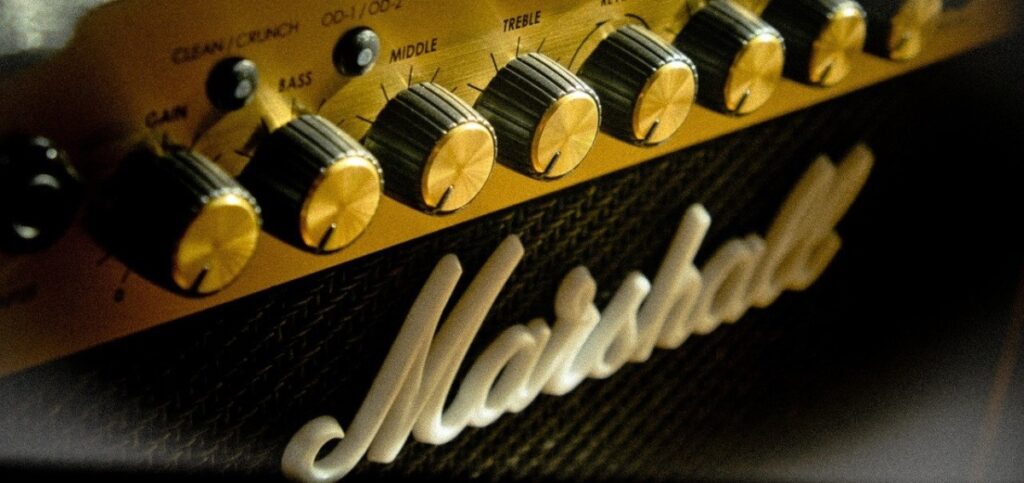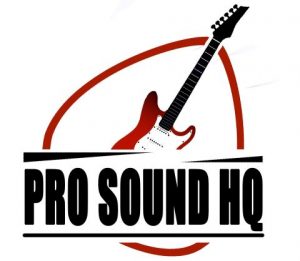The Marshall DSL and Origin series both feature some great electric guitar valve amplifiers, and despite using the same tubes they actually sound very different from one another.
In this article I’ll compare the tone, controls and features of the DSL and Origin combo and head amps to help you figure out which is the best option for you.
Quick Comparison
Marshall DSL amplifiers sound more modern and high-gain compared to Marshall Origin amps which have a more vintage plexi-style tone. DSL amps are more versatile due to their additional channel and built-in reverb. Both the Origin and DSL series have an FX loop but only the DSL amp have an AUX in/ out.
| Specification | Marshall Origin | Marshall DSL |
| Combo Amp Power | 20W or 50W | 20W or 40W |
| Head Unit Power | 20W or 50W | 20W or 100W |
| Speaker (Combo Only) | 1 x 10” Celestion VT-Junior or 1 x 12” Celestion G12N-60 Midnight 60 | 1 x 12” Celestion Seventy 80 or 1 x 12” Celestion V-Type |
| Pre-Amp Valves | 3 x ECC83 | 3/4* x ECC83 |
| Channels | One | Two |
| Controls | Gain Bass, Middle, Treble Presence Boost Tilt | Gain Bass, Middle, Treble Presence Resonance Tone Shift Button Clean/ Crunch Switch* OD1/ OD2 Switch* |
| Effects | None | Reverb Loop* |
| Number of 1/4″ Inputs | 3 | 3/5* |
| AUX Input and Output | No | Yes |
Images link to Amazon
Channels, Controls and Effects
One of the biggest differences between the Origin and DSL series is that Origin amps only have one channel, whereas DSL amps have two channels (ultra gain and classic gain).
On the largest DSL head and combo amps (DSL40C and DSL100H), these two channels are also split into two. The ultra gain channel can be split using the OD1/ OD2 switch for different voicings and the classic gain channel can be split using the clean/ crunch switch.
In terms of the controls, you’ll get a gain control, 3-band EQ (bass, middle and treble) and presence control with both the DSL and Origin amps. Both amps also have some other controls which differ from one another.
DSL Series
- Resonance: allows you to adjust the overall bass response in a similar way to the presence control allowing you to adjust the overall treble response.
- Tone Shift Button: this scoops the mid-range frequencies.
- Reverb: only the DSL series has a built-in digital reverb effect split into two types: classic and ultra.
Origin Series:
- Boost: gives you more overdrive and a fatter tone.
- Tilt: allows you to adjust between high treble and normal (more mellow tones).
Comparing Tones
The Origin and DSL series use the same pre-amp and power-amp tubes. All amps have three ECC83 pre-amp tubes except for the DSL100H and DSL40C which have four. All amps have two EL34 power amp tubes.
One thing that’s different between all amps though is the speaker on the combo versions.
- Origin20C has a 1 x 10” Celestion VT-Junior speaker
- Origin50C has a 1 x 12” Celestion G12N-60 Midnight 60 speaker
- DSL20C has a 1 x 12” Celestion Seventy 80 speaker
- DSL40C has a 1 x 12” Celestion V-Type speaker
The DSL amps are more versatile due to the additional channel which has more gain but it is possible to get a good range of tones from the Origin amp as well, the gain just won’t be as high compared to when you max out the DSL.
- Marshall DSL amps sound more modern, compressed and crunchier compared to Origin amps which sound a bit warmer and have more of a vintage-style tone.
- The DSL works best for metal as it offers more gain.
Check out this YouTube video to hear these amps being played back-to-back, starting with the DSL.
Additional Features
Both the Marshall Origin and DSL have a footswitch and FX loop. Only the DSL amplifiers have an Aux inputs and outputs.
All DSL and Origin amps above 20W have a power output control which makes the amp playable at lower volumes.
Here is a table showing the alternative power ratings for each amp.
| Marshall Amplifier | Power Rating Switch Options |
| Origin 20 Combo and Head | 20W, 3W and 0.5W |
| Origin 50 Combo and Head | 50W, 10W and 5W |
| DSL 20 Combo and Head | 20W and 10W |
| DSL 40 Combo | 40W and 20W |
| DSL 100 Head | 100W and 50W |
As you can see from the table, the power output can be reduced a lot more with the Origin amps compared to DSL amps. Hence, if you go for a DSL40C or DSL100H, then you may struggle to use it and get a good tone in your home when you need to keep the volume lower.
However, the DSL amps do allow you to use headphones to solve this issue since they all have AUX outputs.
All amplifiers in the range have three 1/4″ inputs except for the largest DSL head and combo amps (DSL40C and DSL100H) which have 5 inputs. These are also the only amps in the range to have a looper function built-in.
Only the DSL amplifiers have an Aux inputs and outputs.

Dimensions and Weight
The Marshall Origin and DSL amps have similar dimensions when comparing models with similar power ratings (20W versions and the 40W/ 50W versions. However, the DSL amplifiers are heavier than the Origin amplifiers.
Here are tables comparing the dimensions and weights of each version.
Combo Amplifiers
| Measurement | Origin20C | DSL20C | Origin50C | DSL40C |
| Height | 17.3” (44 cm) | 16.5” (42 cm) | 18.9” (48 cm) | 19.3” (49 cm) |
| Width | 20.5” (52 cm) | 19.7” (50 cm) | 22.8” (58 cm) | 24.4” (62 cm) |
| Depth | 9.4” (24 cm) | 9.8” (25 cm) | 9.6” (24.5 cm) | 9.9” (25.2 cm) |
| Weight | 31 lbs (13.9 kg) | 36 lbs (16.3 kg) | 40 lbs (18.2 kg) | 50 lbs (22.9 kg) |
Head Units
| Measurement | Origin20H | DSL20H | Origin50H | DSL100H |
| Height | 8.9” (22.5cm) | 9.8” (25 cm) | 9” (22.8 cm) | 10.8” (27.4 cm) |
| Width | 20.5” (52 cm) | 19.7” (50 cm) | 22.7” (57.7 cm) | 29.1” (74 cm) |
| Depth | 8.7” (22 cm) | 9.4” (24 cm) | 8.9” (22.5 cm) | 9.5” (24.2 cm) |
| Weight | 20.7 lbs (9.4 kg) | 21.4 lbs (9.7 kg) | 26 lbs (11.8 kg) | 53 lbs (24.2 kg) |
Full List of Amplifier Specifications
Here is a table comparing the Marshall Origin and Marshall DSL combo amplifier features. Note that the table references the 20W and 40W versions of the DSL. The DSL also has 1W and 5W combo amplifiers available.
| Specification | Marshall Origin | Marshall DSL |
| Combo Amp Power | 20W or 50W | 20W or 40W |
| Head Unit Power | 20W or 50W | 20W or 100W |
| Speaker (Combo Only) | 1 x 10” Celestion VT-Junior or 1 x 12” Celestion G12N-60 Midnight 60 | 1 x 12” Celestion Seventy 80 or 1 x 12” Celestion V-Type |
| Pre-Amp Valves | 3 x ECC83 | 3/4* x ECC83 |
| Power-Amp Valves | 2 x EL34 | 2 x EL34 |
| Channels | One | Two |
| Controls | Gain Bass, Middle, Treble Presence Boost Tilt | Gain Bass, Middle, Treble Presence Resonance Tone Shift Button Clean/ Crunch Switch* OD1/ OD2 Switch* |
| Effects | None | Reverb Loop* |
| Power Rating Control | Yes | Yes |
| Inputs | 1 x 1/4″ instrument jack | 1 x 1/4″ instrument jack 1 x 3.5mm jack Aux in |
| Outputs | 3 x 1/4″ jack DI out (1/4″ jack) | 3/5 x 1/4″ jack 1 x 3.5mm line out |
| FX Loop | Yes | Yes |
| Footswitch | PEDL-90016 (Included) | PEDL-90012 (Included) |
If you want to check the current prices of each amp, here are the links to Guitar Center:


